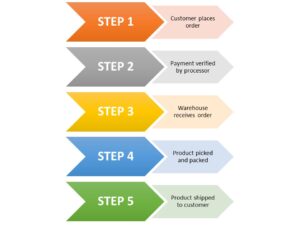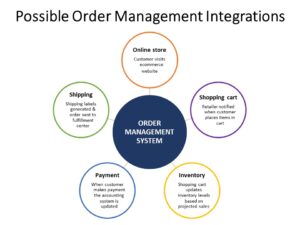How To Solve Inefficiencies In Ecommerce Order Management
Does your online business suffer from inefficiencies in ecommerce order management? Such inefficiencies are not uncommon and typically result from a lack of integration with order acceptance, payment processing, order processing, fulfillment, and other essential operations. To solve these inefficiencies you need to fully integrate your ecommerce website with all your other operations, which you can do with a digital order management system.
How Does Ecommerce Order Management Work?
Ecommerce is increasingly becoming a significant part of the B2C and B2B landscapes. B2C ecommerce in the U.S. is expected to grow 16.1% in 2022, and B2B ecommerce is expected to increase 12% over previous year numbers. This growth is projected to continue, with NASDAQ predicting that by the year 2040 95% of all purchases will be made online.
Managing all these ecommerce orders is a major challenge. All the processes a company employs to accept, track, manage, and fulfill customer orders are collectively referred to as ecommerce order management – and effective order management is essential for the smooth running of any ecommerce business.
Effective ecommerce order management ensures that customers receive exactly what they ordered in a timely fashion. This increases customer satisfaction and builds customer loyalty. Poor order management that results in shipping delays and inaccurate shipments results in unhappy customers and affects your bottom line in the form of returns and replacements.
Ecommerce order management is an essential component of digital sales. For most businesses it’s a five-step process:
- The customer places an order on your ecommerce website.
- The customer’s payment is processed and approved, typically by a third-party payment processor.
- Details of the order are transmitted to the appropriate departments in your company – accounting and shipping/warehousing.
- The item(s) ordered are retrieved from inventory, properly packed, and readied for shipment.
- The order is scheduled for shipment by the appropriate shipping service.
All of this needs to happen in a timely fashion with no mistakes made.
(The following video further explains how order management works.)
What Are Some Common Inefficiencies in Ecommerce Order Management?
As you can see, trying to manage and fulfill orders manually can overwhelm even the most experienced staff. Relying on manual order management can result in errors and inefficiencies. Here are eight of them.
High Cart Abandonment Rates
Online customers abandon their shopping carts for a number of reasons, including encountering a difficult checkout process. An inefficient order management process can result in difficulties in checkout – and customers abandoning your site in favor of an easier-to-use competitor website.
Unexpected Out of Stocks
If your ordering process isn’t closely integrated with your inventory management system you’re likely to experience a higher percentage of out-of-stock situations. If you tell a customer that an item is in stock when it really isn’t, you’ll end up with a dissatisfied customer.
Inaccurate Orders
When you process all your orders manually human error creeps into the process. This often manifests itself in inaccurate orders – the wrong products packed in the wrong boxes and sent to the wrong customers.
Shipping Delays
All of these errors and inefficiencies ultimately result in shipping delays beyond what was promised to your customers. That can cost you money (to expedite orders) and customer satisfaction.
Unnecessarily High Shipping Costs
Manual order management does not provide the kind of detailed information you need to negotiate the lowest possible shipping costs – or offer optimal shipping rates to your customers. Having to expedite shipping because of slow order processing also unnecessarily increases your shipping costs.
Poor Post-Sale Customer Service
If you can’t easily locate an order in your system, you can’t provide adequate post-sale service to your customers. Manual order processing not only results in more errors that require handling customer questions and complaints, but it also makes it more difficult to quickly answer those questions and resolve those issues.
High Return Rates
Packing errors and shipping delays result in higher customer returns. Whether it’s the wrong item, a damaged item, or an item that’s no longer needed, product returns cost you money in either refunds or replacements.
Poor Reporting
Finally, manual order processing simply doesn’t provide the same amount of data that automated order processing can. A lack of detailed data – and of real-time data – make it more difficult for you to run your business effectively and efficiently.
How Can You Solve Inefficient Ecommerce Order Management?
All of these inefficiencies come from a lack of integration and alignment between your ecommerce website and supporting operations. The solution, in all instances, involves implementing a digital order management system and making sure its tightly integrated with your entire operation.
A digital order management system, such as Salesforce Order Management, monitors and manages all stages of the customer journey, from initial order processing through final shipment. The order management system integrates each stage of the order management process with appropriate systems and departments in your organization so that the correct information is transferred in a timely manner.
Consider the following:
- When an online customer places an item in their shopping cart, that information is automatically transmitted to your inventory management system
- The inventory management system compares the order to current inventory and advises the customer on the item’s in-stock or out-of-stock status, along with estimated shipping time
- When the customer places the order and submits payment, payment information is automatically transmitted to the payment processor
- Approved payments are automatically transmitted to your accounting department and the order is approved and finalized
- Approved orders are automatically transmitted to your warehouse where the purchased items are pulled from inventory
- Items taken out of inventory are automatically evaluated for reordering
- Purchased items are properly packed with multiple orders combined when possible
- Shipping labels are automatically generated and the item is prepared for shipment
- The package is turned over to the shipping firm and the customer is automatically notified of shipment
Best of all, all of this data is automatically recorded into your system where it can be accessed by sales, accounting, shipping, and other departments. The data can be used to generate reports and analyzed to provide actionable insights that help you better run your business on a day-to-day basis – over the long term.
Let Rainmaker Help You Deploy Ecommerce Order Management in Your Company
When you need a robust ecommerce order management system, turn to Salesforce and the Salesforce experts at Rainmaker. We can help you deploy Salesforce Order Management, part of Salesforce Commerce Cloud, and integrate it with your existing systems and processes. Salesforce Order Management brings together people, processes, and systems from every stage of the order lifecycle in one centralized, highly efficient system – just what you need to effectively manage your company’s ecommerce orders.
Contact Rainmaker today to learn more about ecommerce order management!







